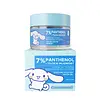What's inside
What's inside
 Key Ingredients
Key Ingredients

 Benefits
Benefits

 Concerns
Concerns

 Ingredients Side-by-side
Ingredients Side-by-side

Niacinamide
SmoothingGlycerin
HumectantSqualane
EmollientCentella Asiatica Extract
CleansingSalicylic Acid
MaskingAmylopectin
Dextrin
AbsorbentSodium Polyacryloyldimethyl Taurate
Emulsion StabilisingHexylresorcinol
AntimicrobialTranexamic Acid
AstringentEctoin
Skin ConditioningCollagen
MoisturisingCalendula Officinalis Flower Extract
MaskingPhenoxyethanol
PreservativeVitis Vinifera Seed Extract
AntimicrobialRosmarinus Officinalis Extract
AntimicrobialHydrogenated Polydecene
EmollientXanthan Gum
EmulsifyingSodium Lauroyl Lactylate
EmulsifyingSodium Hyaluronate
HumectantAllantoin
Skin ConditioningTrideceth-10
CleansingCeramide NP
Skin ConditioningCeramide AP
Skin ConditioningPhytosphingosine
Skin ConditioningCholesterol
EmollientCarbomer
Emulsion StabilisingEthylhexylglycerin
Skin ConditioningCeramide EOP
Skin ConditioningNiacinamide, Glycerin, Squalane, Centella Asiatica Extract, Salicylic Acid, Amylopectin, Dextrin, Sodium Polyacryloyldimethyl Taurate, Hexylresorcinol, Tranexamic Acid, Ectoin, Collagen, Calendula Officinalis Flower Extract, Phenoxyethanol, Vitis Vinifera Seed Extract, Rosmarinus Officinalis Extract, Hydrogenated Polydecene, Xanthan Gum, Sodium Lauroyl Lactylate, Sodium Hyaluronate, Allantoin, Trideceth-10, Ceramide NP, Ceramide AP, Phytosphingosine, Cholesterol, Carbomer, Ethylhexylglycerin, Ceramide EOP
Water
Skin ConditioningPanthenol
Skin ConditioningCentella Asiatica Extract
CleansingPropylene Glycol
HumectantGlycerin
HumectantArtemisia Vulgaris Extract
Skin ConditioningHordeum Vulgare Extract
EmollientAloe Barbadensis Leaf Extract
EmollientAnthemis Nobilis Flower Extract
MaskingMelaleuca Alternifolia Leaf Extract
PerfumingCeramide NP
Skin ConditioningSodium Hyaluronate Crosspolymer
HumectantSodium Hyaluronate
HumectantSodium Acetylated Hyaluronate
HumectantHyaluronic Acid
HumectantHydrolyzed Glycosaminoglycans
HumectantHydrolyzed Sodium Hyaluronate
Skin ConditioningHydrolyzed Hyaluronic Acid
HumectantPhenoxyethanol
PreservativeAcrylates/C10-30 Alkyl Acrylate Crosspolymer
Emulsion StabilisingTriethanolamine
Buffering1,2-Hexanediol
Skin ConditioningAmmonium Acryloyldimethyltaurate/Vp Copolymer
Disodium EDTA
PEG-7 Glyceryl Cocoate
EmulsifyingSodium Benzoate
MaskingPotassium Sorbate
PreservativeCitric Acid
BufferingPolysorbate 60
EmulsifyingBiosaccharide Gum-1
HumectantWater, Panthenol, Centella Asiatica Extract, Propylene Glycol, Glycerin, Artemisia Vulgaris Extract, Hordeum Vulgare Extract, Aloe Barbadensis Leaf Extract, Anthemis Nobilis Flower Extract, Melaleuca Alternifolia Leaf Extract, Ceramide NP, Sodium Hyaluronate Crosspolymer, Sodium Hyaluronate, Sodium Acetylated Hyaluronate, Hyaluronic Acid, Hydrolyzed Glycosaminoglycans, Hydrolyzed Sodium Hyaluronate, Hydrolyzed Hyaluronic Acid, Phenoxyethanol, Acrylates/C10-30 Alkyl Acrylate Crosspolymer, Triethanolamine, 1,2-Hexanediol, Ammonium Acryloyldimethyltaurate/Vp Copolymer, Disodium EDTA, PEG-7 Glyceryl Cocoate, Sodium Benzoate, Potassium Sorbate, Citric Acid, Polysorbate 60, Biosaccharide Gum-1
 Reviews
Reviews

Ingredients Explained
These ingredients are found in both products.
Ingredients higher up in an ingredient list are typically present in a larger amount.
Centella Asiatica Extract (Centella) is derived from an herb native to Southeast Asia. It is famous for its anti-inflammatory and soothing properties.
Centella is rich in antioxidants and amino acids, such as Madecassic Acid and Asiaticoside.
Studies show the compounds in centella help with:
The combination of all these properties makes centella effective at soothing, hydrating, and protecting the skin.
Other great components of centella include Vitamin A, vitamin C, several B vitamins, and Asiatic Acid.
Fun fact: Centella has been used as a medicine and in food for many centuries. As a medicine, it is used to treat burns, scratches, and wounds.
Learn more about Centella Asiatica ExtractCeramide NP is a type of ceramide and formally known as ceramide 3.
Ceramides are intercellular lipids naturally found in our skin that bonds dead skin cells together to create a barrier. They are known for their ability to hold water and thus are a great ingredient for dry skin.
Ceramides are an important building block for our skin barrier. A stronger barrier helps the skin look more firm and hydrated. By bolstering the skin ceramides act as a barrier against irritating ingredients. This can help with inflammation as well.
If you would like to eat ceramides, sweet potatoes contain a small amount.
Read more about other common types of ceramides here:
Ceramide AP
Ceramide EOP
Glycerin is already naturally found in your skin. It helps moisturize and protect your skin.
A study from 2016 found glycerin to be more effective as a humectant than AHAs and hyaluronic acid.
As a humectant, it helps the skin stay hydrated by pulling moisture to your skin. The low molecular weight of glycerin allows it to pull moisture into the deeper layers of your skin.
Hydrated skin improves your skin barrier; Your skin barrier helps protect against irritants and bacteria.
Glycerin has also been found to have antimicrobial and antiviral properties. Due to these properties, glycerin is often used in wound and burn treatments.
In cosmetics, glycerin is usually derived from plants such as soybean or palm. However, it can also be sourced from animals, such as tallow or animal fat.
This ingredient is organic, colorless, odorless, and non-toxic.
Glycerin is the name for this ingredient in American English. British English uses Glycerol/Glycerine.
Learn more about GlycerinPhenoxyethanol is a preservative that has germicide, antimicrobial, and aromatic properties. Studies show that phenoxyethanol can prevent microbial growth. By itself, it has a scent that is similar to that of a rose.
It's often used in formulations along with Caprylyl Glycol to preserve the shelf life of products.
Sodium Hyaluronate is hyaluronic acid's salt form. It is commonly derived from the sodium salt of hyaluronic acid.
Like hyaluronic acid, it is great at holding water and acts as a humectant. This makes it a great skin hydrating ingredient.
Sodium Hyaluronate is naturally occurring in our bodies and is mostly found in eye fluid and joints.
These are some other common types of Hyaluronic Acid:
Learn more about Sodium Hyaluronate